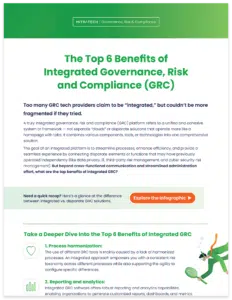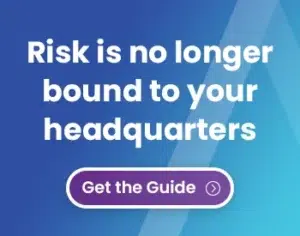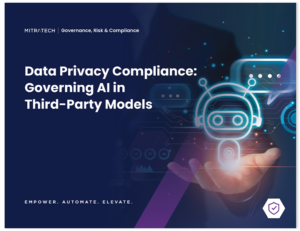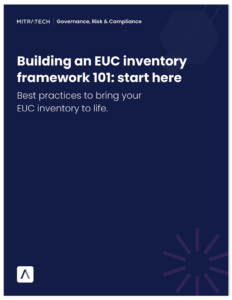Best practices and expert advice for bringing your disparate systems together for a more integrated approach to GRC.
A robust Governance, Risk, and Compliance (GRC) strategy is essential for organizations to navigate regulatory requirements, manage risks effectively, and uphold operational integrity. Cyber risks are growing exponentially; September 2023 saw a year-high of 3.8 MILLION compromised records, bringing the year’s total to 4.5 BILLION. As a result, AI governance is evolving and shifting, and our reliance on third party systems is increasing (and with a larger ecosystem of suppliers comes greater risk). Businesses are no longer able to “keep up” with piecemeal approaches to GRC.
An integrated GRC framework refers to a unified and cohesive system or framework that combines various components, tools, or technologies into a single, comprehensive solution. The goal of an integrated platform is to harmonize processes, enhance efficiency, and provide a seamless experience by connecting disparate elements or functions that may have previously operated independently.
Let’s dive into 25 tips and tools that you should consider when approaching your integrated GRC framework.

Integrate Your Approach for Your Tech Stack
70% of organizations state that they have a strategy going forward for GRC integration and collaboration. But does that mean that their GRC framework holds an integrated approach?
- Whenever your team faces a new challenge in the GRC space, first consider whether your current platforms can accommodate it, configure for it, or whether working with a known vendor will open up new possibilities
- Create a consolidated risk management inventory with intuitive features like built-in dashboard widgets and access control across business units
- Integrate capabilities and data across your data privacy, IT, third-party risk management, and cyber security risk management
- Support cross-functional communication across your GRC products by ensuring that your tools are scalable no matter how many teams/users are needed
- Provide a holistic, 360-degree view of risk and controls (like SOC & NIST) from one centralized dashboard – so you can report on multiple frameworks at the same time
Stay Ahead of Changing Regulations
With regulatory compliance more interconnected and extended across borders than ever before, businesses must be prepared to respond to the risks facing themselves and their vendors. And their vendor’s vendors. Your GRC framework must have policies in place to keep track of your extended vendor network, bringing information on your far-reaching suppliers in one place and under your control.
The fact is, if your company doesn’t have some sort of vendor compliance policy already in place to monitor third-party and nth-party risk, you’re leaving yourself vulnerable to the unforeseen costs and risks associated with non-compliance.
An integrated GRC tech stack will include tools that:
- Monitor changing regulations and understand how and where you are responsible – for example, even if the headquarters of your company is in a location that is not responsible to certain regulations, you are also responsible for the regulations in place in every location you operate
- Keep you compliant by empowering you to ensure your vendors, partners, and other third parties are complying with your internal policies and procedures
Some tips for extending your compliance with new regulations:
- Create a tiering process to categorize vendors according to their risk potential (a vendor that deals with proprietary or sensitive data on a daily basis, for example, would be considered high risk)
- Have the appropriate controls in place for each vendor based on where they fall within the tiering process
- Define a cadence for that vendor relationship – for high-risk vendors (like an ATM provider, for example), there should be a close relationship where you catch up regularly
Get Ready to Govern AI:
Generative AI has emerged as a new tool to help businesses with compliance, but while it holds great potential, it will require a framework around it to make it safe.
Organizations must consider relevant compliance standards to ensure safe and responsible use. 34% of companies currently use AI, a number that is continuously growing while an additional 42% explore AI.
Best practices for generative AI compliance include:
- Follow standards of responsible data handling and storage
- Always explain the origin and limitations of generated content
- Thoroughly evaluate generative AI providers
- Conduct regular risk assessments and audits
- Educate users and stakeholders
With these best practices in mind, don’t forget to look for a tool – integrated into your GRC tech stack — that can support your AI framework. You want to be able to answer “Yes!” when asked whether you have a governance policy in place that’s effective, measurable, and defensible.
Your GRC platform should provide:
- A single, centralized inventory of AI and ML technology within your firm
- Customizable, consistent risk rating of AI against firms’ risk appetite
- Full visibility of validation and testing of AI
- Full version and change control with transparency around peer review – particularly when not in control of IT
- Technical scanning capabilities to ensure the completeness of the AI inventory
Build Longevity Into Your EUC Risk Management
In order to centralize and streamline your GRC framework, you must not only manage your known risks, but also the risks that are hidden in the applications that grow within your organization. End-User Computing risk management ties into your larger goals for shadow IT and hidden applications that fall outside of your IT team’s purview.
(EUC) risk management can seem overwhelming, especially given the increasing regulatory scrutiny organizations face today. But failing to implement the right EUC controls and provide evidence of those controls leaves your enterprise vulnerable to risk.
To navigate these challenges, every organization should establish a standardized framework for identifying, mitigating, and managing EUC risks through effective controls and strategic decisions.
One crucial aspect of EUC risk management is maintaining a comprehensive EUC inventory. This inventory plays a critical role in enabling proactive maintenance, risk mitigation, and compliance efforts.
Your EUC inventory should:
- Capture all of your company’s EUCs
- Capture meta-data to calculate the materiality of each EUC in terms of the financial, regulatory, operational or reputational risk and impact
- Have built-in workflows to facilitate the updating and continuous monitoring of your EUCs based on their materiality/assigned tier
- Provide controls as well as evidence of these controls
- Use a combination of manual attestation and formalized discovery to continuously attest to the validity of the inventory
Integrating capabilities and data across various domains like data privacy, IT, cyber, and third-party risk management provides a comprehensive view of risks, vulnerabilities, and incidents to facilitate informed governance, risk, and compliance decisions. An integrated approach not only elevates decision-making processes but also ensures continuous improvement.
Our focus? On your success.
Schedule a demo, or learn more about Mitratech’s products, services, and commitment.






